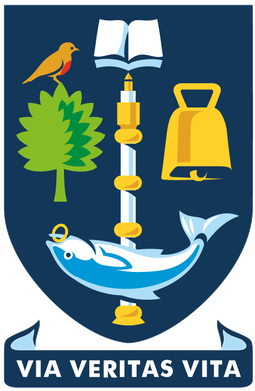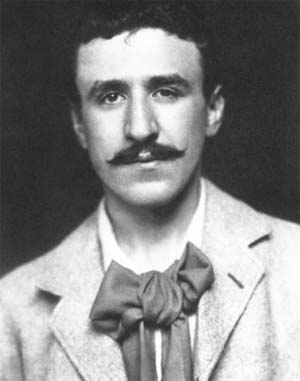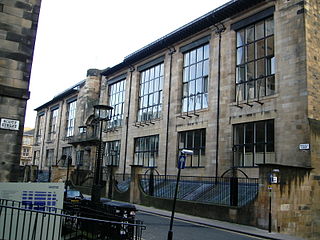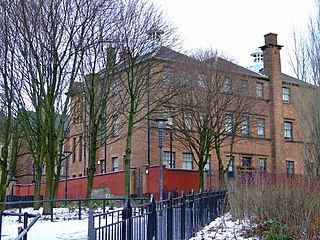
The University of Glasgow is a public research university in Glasgow, Scotland. Founded by papal bull in 1451 [O.S. 1450], it is the fourth-oldest university in the English-speaking world and one of Scotland's four ancient universities. Along with the universities of St Andrews, Aberdeen, and Edinburgh, the university was part of the Scottish Enlightenment during the 18th century. Glasgow is the largest university in Scotland by total enrolment and with over 19,500 postgraduates the second-largest in the United Kingdom by postgraduate enrolment.

Charles Rennie Mackintosh was a Scottish architect, designer, water colourist and artist. His artistic approach had much in common with European Symbolism. His work, alongside that of his wife Margaret Macdonald, was influential on European design movements such as Art Nouveau and Secessionism and praised by great modernists such as Josef Hoffmann. Mackintosh was born in Glasgow and died in London. He is among the most important figures of Modern Style.

Margaret Macdonald Mackintosh was an English-born artist who worked in Scotland, and whose design work became one of the defining features of the Glasgow Style during the 1890s to 1900s.

The Glasgow School of Art is a higher education art school based in Glasgow, Scotland, offering undergraduate degrees, post-graduate awards, and PhDs in architecture, fine art, and design.

North Kelvinside is a residential district of the Scottish city of Glasgow.

Scotland Street School Museum is a museum of school education in Glasgow, Scotland, in the district of Kingston. It is located in a former school designed by Charles Rennie Mackintosh between 1903 and 1906. The building is one of Glasgow's foremost architectural attractions. It is located next to the Shields Road subway station.

Queen's Cross Church is a former Church of Scotland parish church in Glasgow, Scotland. It is the only church designed by Charles Rennie Mackintosh to have been built; hence, it is also known as The Mackintosh Church.

The Willow Tearooms are tearooms at 217 Sauchiehall Street, Glasgow, Scotland, designed by internationally renowned architect Charles Rennie Mackintosh, which opened for business in October 1903. They quickly gained enormous popularity, and are the most famous of the many Glasgow tearooms that opened in the late 19th and early 20th century. The building was fully restored, largely to Mackintosh's original designs, between 2014 and 2018. It was re-opened as working tearooms in July 2018 and trades under the name "Mackintosh at The Willow". This follows a trademark dispute with the former operator of The Willow Tearooms which was resolved in 2017. That name is now used at tearoom premises in Buchanan Street and was additionally used at the Watt Brothers Department Store in Sauchiehall Street, Glasgow between 2016 and its closure in 2019.

The Martyrs’ Public School, in Parson Street in the Townhead area of Glasgow, Scotland, is one of the earlier works of architect Charles Rennie Mackintosh. Until recently, an arts centre run by Glasgow Museums, it is now home to Glasgow City Council's Social Work Leaving Care Services. It is protected as a category A listed building. Stranded above the main road it was once set in the middle of a densely populated area of tenement buildings. It was built following the Education (Scotland) Act 1872 which provided for increased public expenditure on education. Commissioned by the School Board of Glasgow and built between 1895 and 1898, the architects were Honeyman and Keppie.

The Glasgow Society of Lady Artists was founded in 1882 by eight female students of the Glasgow School of Art with the aim of affording due recognition to women in the field of art. It has been described by Jude Burkhauser as "the first residential club in Scotland run by and for women". In the early days of the club, they met at 136 Wellington Street, Glasgow.

Glasgow Art Club is a club for artists and non-artists interested in the creation and enjoyment of art - all illustrative arts, sculptures, poetry, prose, plays, music, song, choreography and dance. To advance, promote and encourage the arts in all forms. Each year it has a range of exhibitions, events and concerts, open to the public for their enjoyment; and, subject to club events, a number of its rooms are available as venues for social occasions.
Honeyman and Keppie was a major architectural firm based in Glasgow, created by John Honeyman and John Keppie in 1888 following the death of James Sellars in whose architectural practice Keppie had worked. Their most notable employee was Charles Rennie MacKintosh, who started as a draughtsman in April 1889 and rose to partner level. The creation of the new Honeyman, Keppie and MacKintosh marked the next phase in the evolution of the practice which as Honeyman and Keppie existed from 1888 to 1904.
Events from the year 1895 in Scotland.

John Keppie was a Glasgow architect and artist. From an early age he was a close friend of Edward Atkinson Hornel and would often bring in New Year with him in Kirkcudbright. Within the architectural profession, he was closest to John Archibald Campbell, and is credited with training Charles Rennie Mackintosh.

Janet Anne Galloway (1841–1909) was an advocate for higher education for women in Scotland, supporter of the Glasgow Association for the Higher Education of Women and secretary of Queen Margaret College.

Jessie (Janet) Campbell (1827–1907) was a British woman who helped to create the first higher education college for women in Scotland.
Peter Donald Thomson (1872–1955) was a Scottish minister who served as Moderator of the General Assembly of the Church of Scotland in 1934.

Jessie Keppie (1868-1951) was an artist from Glasgow, Scotland, described as one of the "leading women proponents of the Glasgow Style".

Janet Macdonald Aitken CBE (1873–1941) was a Scottish portrait and landscape painter. She was described by Jude Burkhauser as "one of the leading women proponents of the Glasgow Style."

John Honeyman was a Scottish architect. He designed several notable buildings in Scotland, mostly churches, and worked alongside Charles Rennie Mackintosh as a partner for several years.

















